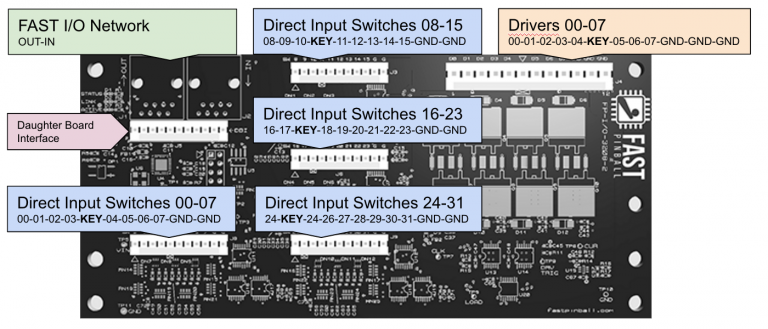How to configure switches (FAST Pinball)
Related Config File Sections:
To configure switches with FAST Pinball hardware, you can follow the guides and instructions in the Switches docs.
However there are a few things to know and some additional options you get with FAST hardware that is discussed here.
number:
When you're using FAST IO boards, switches plug into individual IO boards. Then the IO boards are connected together in a loop.

The number: setting for each switch is its board's position number in
the chain, then the dash, then the switch input number. Note that the
position number starts with zero, so the first IO board in the chain is
0, the second is 1, etc.
switches:
my_switch:
number: 0-0 # first board, switch 0
some_other_switch:
number: 2-24 # third board, switch 24
Notes:
- The first board in the chain is board 0.
- The boards are counted in the direction of the "out" connector on the controller board.
- Different models of IO boards have different numbers of switches, and MPF will make sure that the numbers work for each type of board. (e.g. a switch number 10 isn't valid on an 0804 board since that board only has 8 switches numbered 0-7).
Also note that prior versions of MPF just numbered all the switches in one continuous sequence from the first board through the last, but that was confusing. You can still do that if you want (in integer format), but we feel the board-input format is much easier to understand.
Debounce options
FAST controllers have advanced capabilities when it comes to debouncing switches. (More on what that is here).
Since FAST switches are directly connected (e.g. there is no switch matrix), and since every FAST IO board has its own processor and firmware, the states of switches are checked often (every 1ms). You can specify the exact debounce time that a switch must consistently be in a new state in both the open and close directions.
Specifying default debounce settings
By default, MPF provides two debounce profiles for switches ("normal"
and "quick"). When using FAST pinball controllers, the "normal"
debounce profile is 4ms for both the debounce open and debounce closed
times, and the "quick" debounce profile is 2ms for both debounce
open and closed times.
You can change any of these in the fast: section of your machine-wide
config, like this:
fast:
default_quick_debounce_open: 2ms
default_quick_debounce_close: 2ms
default_normal_debounce_open: 4ms
default_normal_debounce_close: 4ms
(Note that other settings from the fast: section of your config have
not been included here for clarity.)
Per-switch debounce settings
When using FAST Pinball controllers, you can also specify the debounce
open and debounce closed settings on a per-switch basis. To do that,
just add a debounce_open: and/or debounce_close: setting to an
individual switch, like this:
switches:
my_switch:
number: 1-0
platform_settings:
debounce_open: 5ms
debounce_close: 20ms
some_other_switch:
number: 3-24
Valid values are 1 to 255 ms.
What if it did not work?
Have a look at our FAST troubleshooting guide.
Something missing or wrong? You can fix it!
This website is edited by people like you! Is something wrong or missing? Is something out of date, or can you explain it better?
Please help us! You can fix it yourself and be an official "open source" contributor!
It's easy! See our Beginner's guide to editing the docs.
Page navigation via the keyboard: < >
You can navigate this site via the keyboard. There are two modes:
General navigation, when search is not focused:
- F , S , / : open search dialog
- P , , : go to previous page
- N , . : go to next page
While using the search function:
- Down , Up : select next / previous result
- Esc , Tab : close search
- Enter : go to highlighted page in the results